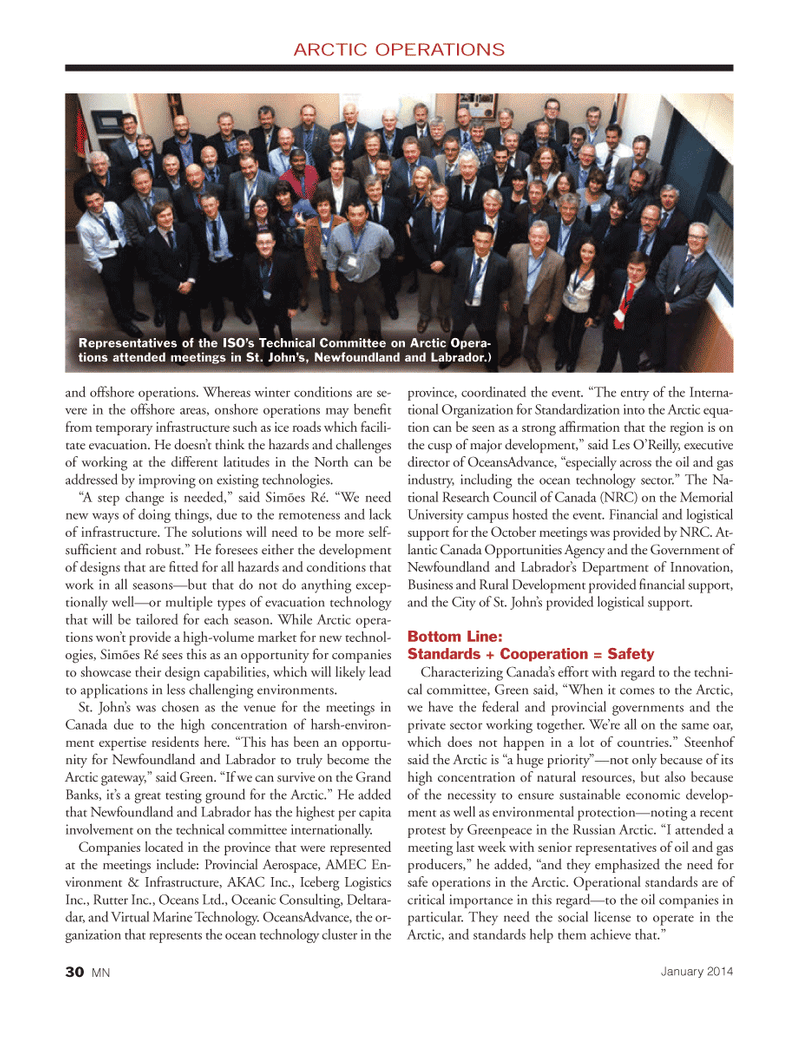
Page 30: of Marine News Magazine (January 2014)
Tug Boat Technology
Read this page in Pdf, Flash or Html5 edition of January 2014 Marine News Magazine
and offshore operations. Whereas winter conditions are se- vere in the offshore areas, onshore operations may benefi t from temporary infrastructure such as ice roads which facili- tate evacuation. He doesn’t think the hazards and challenges of working at the different latitudes in the North can be addressed by improving on existing technologies. “A step change is needed,” said Simões Ré. “We need new ways of doing things, due to the remoteness and lack of infrastructure. The solutions will need to be more self- suffi cient and robust.” He foresees either the development of designs that are fi tted for all hazards and conditions that work in all seasons—but that do not do anything excep- tionally well—or multiple types of evacuation technology that will be tailored for each season. While Arctic opera- tions won’t provide a high-volume market for new technol- ogies, Simões Ré sees this as an opportunity for companies to showcase their design capabilities, which will likely lead to applications in less challenging environments.
St. John’s was chosen as the venue for the meetings in
Canada due to the high concentration of harsh-environ- ment expertise residents here. “This has been an opportu- nity for Newfoundland and Labrador to truly become the
Arctic gateway,” said Green. “If we can survive on the Grand
Banks, it’s a great testing ground for the Arctic.” He added that Newfoundland and Labrador has the highest per capita involvement on the technical committee internationally.
Companies located in the province that were represented at the meetings include: Provincial Aerospace, AMEC En- vironment & Infrastructure, AKAC Inc., Iceberg Logistics
Inc., Rutter Inc., Oceans Ltd., Oceanic Consulting, Deltara- dar, and Virtual Marine Technology. OceansAdvance, the or- ganization that represents the ocean technology cluster in the province, coordinated the event. “The entry of the Interna- tional Organization for Standardization into the Arctic equa- tion can be seen as a strong affi rmation that the region is on the cusp of major development,” said Les O’Reilly, executive director of OceansAdvance, “especially across the oil and gas industry, including the ocean technology sector.” The Na- tional Research Council of Canada (NRC) on the Memorial
University campus hosted the event. Financial and logistical support for the October meetings was provided by NRC. At- lantic Canada Opportunities Agency and the Government of
Newfoundland and Labrador’s Department of Innovation,
Business and Rural Development provided fi nancial support, and the City of St. John’s provided logistical support.
Bottom Line:
Standards + Cooperation = Safety
Characterizing Canada’s effort with regard to the techni- cal committee, Green said, “When it comes to the Arctic, we have the federal and provincial governments and the private sector working together. We’re all on the same oar, which does not happen in a lot of countries.” Steenhof said the Arctic is “a huge priority”—not only because of its high concentration of natural resources, but also because of the necessity to ensure sustainable economic develop- ment as well as environmental protection—noting a recent protest by Greenpeace in the Russian Arctic. “I attended a meeting last week with senior representatives of oil and gas producers,” he added, “and they emphasized the need for safe operations in the Arctic. Operational standards are of critical importance in this regard—to the oil companies in particular. They need the social license to operate in the
Arctic, and standards help them achieve that.”
ARCTIC OPERATIONS
Representatives of the ISO’s Technical Committee on Arctic Opera- tions attended meetings in St. John’s, Newfoundland and Labrador.)
January 2014 30 MN
MN JAN14 Layout 18-31.indd 30 12/20/2013 10:08:17 AM

 29
29

 31
31
